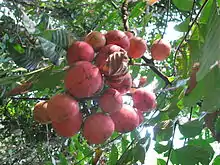Chisocheton
Chisocheton is a genus of trees in the family Meliaceae.[2] The genus name comes from the Greek schizos and chiton meaning "split tunic", referring to the lobed staminal tube of C. patens. Their range is from India and tropical China, throughout Malesia and south to New South Wales and Vanuatu.[1]
| Chisocheton | |
|---|---|
 | |
| Fruits of Chisocheton cumingianus subsp. balansae | |
| Scientific classification | |
| Kingdom: | Plantae |
| Clade: | Tracheophytes |
| Clade: | Angiosperms |
| Clade: | Eudicots |
| Clade: | Rosids |
| Order: | Sapindales |
| Family: | Meliaceae |
| Subfamily: | Melioideae |
| Genus: | Chisocheton Blume[1] |
| Species | |
|
See text | |
Description
Flowers are usually unisexual, rarely bisexual, with a cup-shaped calyx. Fruits are one or two-seeded. Chisocheton habitats are rain forests, typically understorey trees, from sea-level to about 1,500 metres (5,000 ft) altitude.
The wood of several Chisocheton species is used locally in light construction.[1] In the Philippines, the seeds of Chisocheton cumingianus (known locally as balukanag) are used to make a non-drying oil either for traditional medicine or as fuel for oil lamps.[3]
Species
As of February 2014 The Plant List recognises 53 accepted species (including infraspecific names):[2]
- Chisocheton aenigmaticus Mabb.
- Chisocheton amabilis Miq.
- Chisocheton cauliflorus Merr.
- Chisocheton celebicus Koord.
- Chisocheton ceramicus Miq.
- Chisocheton crustularii Mabb.
- Chisocheton cumingianus (C.DC.) Harms
- subsp. balansae (C.DC.) Mabb.
- subsp. kinabaluensis (Merr.) Mabb.
- Chisocheton curranii Merr.
- Chisocheton diversifolius Miq.
- Chisocheton dysoxylifolius Kurz
- Chisocheton erythrocarpus Hiern
- Chisocheton gliroides P.F.Stevens
- Chisocheton granatum Mabb.
- Chisocheton grandiflorus Kurz
- Chisocheton koordersii Mabb.
- Chisocheton lansiifolius Mabb.
- Chisocheton laosensis Pellegr.
- Chisocheton lasiocarpus (Miq.) Valeton
- Chisocheton lasiogynus Boerl. & Koord.
- Chisocheton longistipitatus (F.M.Bailey) L.S.Sm.
- Chisocheton macranthus (Merr.) Airy Shaw
- Chisocheton macrophyllus King
- Chisocheton maxilla-pisticis Mabb.
- Chisocheton medusae Airy Shaw
- Chisocheton mendozai F.H.Hildebr. ex Steenis
- Chisocheton montanus P.F.Stevens
- Chisocheton novobritannicus P.F.Stevens
- Chisocheton patens Blume
- Chisocheton pauciflorus King
- Chisocheton pellegrinianus Mabb.
- Chisocheton penduliflorus Planch. ex Hiern
- Chisocheton pentandrus (Blanco) Merr.
- subsp. paucijugus (Miq.) Mabb.
- Chisocheton perakensis (Hemsl.) Mabb.
- Chisocheton pilosus C.DC.
- Chisocheton pohlianus Harms
- Chisocheton polyandrus Merr.
- Chisocheton rex Mabb.
- Chisocheton ruber Ridl.
- Chisocheton sapindinus P.F.Stevens
- Chisocheton sarasinorum Harms
- Chisocheton sarawakanus (C.DC.) Harms
- Chisocheton sayeri (C.DC.) P.F.Stevens
- Chisocheton schoddei P.F.Stevens
- Chisocheton setosus Ridl.
- Chisocheton stellatus P.F.Stevens
- Chisocheton tenuis P.F.Stevens
- Chisocheton tomentosus (Roxb.) Mabb.
- Chisocheton velutinus Mabb.
- Chisocheton vindictae Mabb.
- Chisocheton warburgii Harms
References
- Mabberley, David J.; Sing, Anne M. (March 2007). "Chisocheton Blume". In Soepadmo, E.; Saw, L. G.; Chung, R. C. K.; Kiew, Ruth (eds.). Tree Flora of Sabah and Sarawak. (free online from the publisher, lesser resolution scan PDF versions). 6. Forest Research Institute Malaysia. pp. 115–143. ISBN 983-2181-89-5. Archived from the original (PDF) on 27 September 2013. Retrieved 8 February 2014.
- "Chisocheton". The Plant List. Retrieved 8 February 2014.
- Orosa, Rosalinda L. "Tree of the month (part2) Balukanag (Chisocheton cumingianus)". PhilStar Global. Retrieved 17 June 2018.
External links
- "Chisocheton Blume". Atlas of Living Australia.